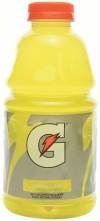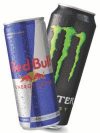Open for Discussion: Performance Drinks... Are They Safe?
By Raima Larter October/November 2017
When exercising, many people consume a variety of beverages—such as sports drinks, energy drinks, and low-calorie drinks—instead of water. Are they a good alternative to water to stay hydrated, and are they safe to consume?
What’s in sports drinks?
Sports drinks contain mainly water, sugar, salt, and small amounts of flavorings and colors. Sugar in these drinks—labeled as “carbs”—makes the drinks taste better, but also helps speed the absorption of water by the intestines. Some people feel a little queasy when they consume pure water too quickly after sweating a lot, and sugar can help prevent this. The other main ingredients in sports drinks are electrolytes, mainly sodium (Na+) and potassium (K+), which are paired with a variety of anions in the form of soluble salts. Some brands also include other cations such as calcium (Ca2+) and magnesium (Mg2+).
The amount of sugar in sports drinks can be quite high. A 12-ounce serving of Gatorade® can contain as many as 21 grams (g) of sugar. This puts sports drinks in the same category as soda when it comes to sugary drinks.

Energy drinks
Energy drinks, such as Red Bull®, contain more sugar than sports drinks—37 g in one can. Energy drinks may also contain caffeine, guarana, and taurine, all of which are stimulants and should be avoided by young people.
In a 2011 report, the American Academy of Pediatrics stated that “energy drinks are never appropriate for children or adolescents.” Stimulants act as diuretics, which means they encourage the excretion of water by the body—this works against an athlete’s attempt to rehydrate.
According to the U.S. Department of Agriculture, which sets recommended daily allowances of nutrients, no more than 10% of a person’s daily calories should come from added sugar. If an average adult consumes 2,000 calories, and each gram of sugar contributes 9 calories, then what is the daily limit of grams of added sugar that an adult should not exceed?

How about low-calorie drinks?
Low-carb or low-calorie sports drinks contain sugar in the form of glucose or fructose, as opposed to table sugar, which is sucrose. These drinks may also contain synthesized sweet-tasting substances sucralose, acesulfame potassium, or aspartame. These other sweeteners are sweeter per unit mass, which means you can use less (for fewer calories). Some artificial sweeteners are not digested and have no calories.
The bottom line
If you exercise heavily, you may want to consider one of these beverages, but know what you’re consuming and check the ingredients list before you drink. In particular, look for the amount of sugar, caffeine, and sweeteners, and learn about the recommended daily values. On the basis of what you’ve learned from this article and your own research, which sports drinks, energy drinks, or low-calorie drinks would you consume? Consider your level of exercise and what you want to achieve from consuming these beverages.
Source: Facts about Low-Calorie Sweeteners. Food Insight, Sept 17, 2014, (updated April 24 2017) http://www.foodinsight.org/articles/facts-about-low-calorie-sweeteners-0 (accessed Sept 2017).
Also in this Issue...
COMPOST: YOUR TRASH, NATURE'S TREASURE
Composting is a way to harvest crops with natural fertilizer and reduce our contribution to greenhouse gases—a win-win!


